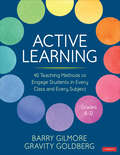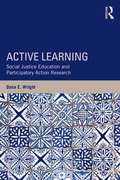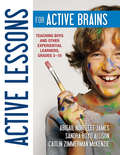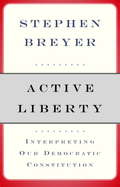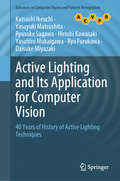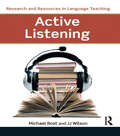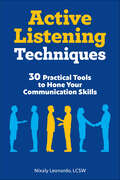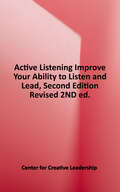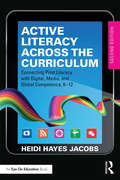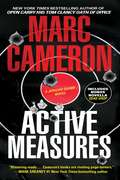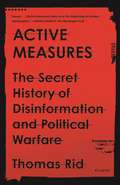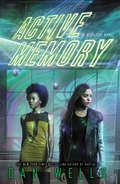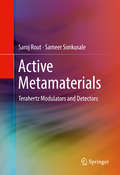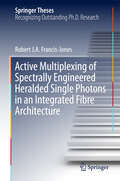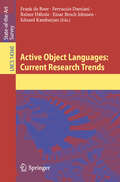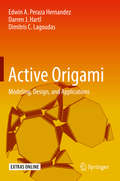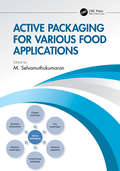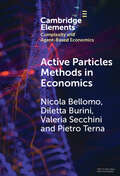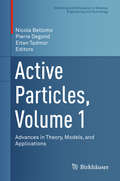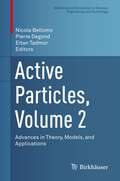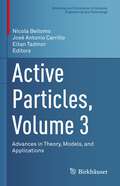- Table View
- List View
Active Learning: 40 Teaching Methods to Engage Students in Every Class and Every Subject, Grades 6-12 (Corwin Teaching Essentials)
by Gravity Goldberg Barry GilmoreTried and true teaching strategies to boost student engagement. Students need to be actively engaged to learn—intellectually curious, physically active, and emotionally involved in collaborative work that builds their capacity for empathy. What can teachers do to instill these elements in the classroom? Active Learning: 40 Teaching Methods To Engage Students In Every Class and Every Subject is the actionable tool every new and veteran teacher needs to construct dynamic learning experiences for students. This hands-on, easy-to-use guide features 40 carefully curated, high-impact teaching strategies that target learning tools, collaboration structures, reading and writing routines, assessment opportunities and more. It includes: Step-by-step teaching strategies that can be mastered quickly and implemented in any order Tools to help teachers identify the most pressing classroom needs and determine which methods to try first Nine instructional structures including essential questions, strategy groups, stations, and simulations Real-world examples, tips, templates, and other supportive resources that offer guidance for each method, identify common challenges, and detail next steps Whether tweaking your existing strategies or finding new moves that will quickly become your own, this is your go-to guide for designing active, engaging learning experiences for students.
Active Learning: Social Justice Education and Participatory Action Research (Teaching/Learning Social Justice)
by Dana E. WrightWhile many educators acknowledge the challenges of a curriculum shaped by test preparation, implementing meaningful new teaching strategies can be difficult. Active Learning presents an examination of innovative, interactive teaching strategies that were successful in engaging urban students who struggled with classroom learning. Drawing on rich ethnographic data, the book proposes participatory action research as a viable approach to teaching and learning that supports the development of multiple literacies in writing, reading, research and oral communication. As Wright argues, in connecting learning to authentic purposes and real world consequences, participatory action research can serve as a model for meaningful urban school reform. After an introduction to the history and demographics of the working-class West Coast neighborhood in which the described PAR project took place, the book discusses the "pedagogy of praxis" method and the project’s successful development of student voice, sociopolitical analysis capacities, leadership skills, empowerment and agency. Topics addressed include an analysis and discussion of the youth-driven PAR process, the reactions of student researchers, and the challenges for adults in maintaining youth and adult partnerships. A thought-provoking response to current educational challenges, Active Learning offers both timely implications for educational reform and recommendations to improve school policies and practices.
Active Lessons for Active Brains: Teaching Boys and Other Experiential Learners, Grades 3-10
by Caitlin Zimmerman Mckenzie Sandra Boyd Allison Abigail Norfleet JamesLearn what to do when your students' feet just can't keep still.If you have had enough of repeating yourself to students who aren't listening, try a little less talk and a lot more action. The authors of Active Lessons for Active Brains have assembled an indispensable, ready-to-use collection of mathematics, language arts, science, and classroom management strategies to focus a classroom full of energetic minds. Designed for active, hands-on learners-whether male or female-the text provides more than 70 specific lesson plans for addressing students' common challenges, already differentiated to match their experiential learning style.The many benefits of using this book include: A more orderly classroom Enhanced capacity to focus on tasks Improved retention of subject matter Increased student engagementThis book contains a wealth of examples, visuals, and material that can be easily reproduced in the classroom. Suitable for upper elementary to high school students, lesson plans can be readily adapted to suit any curriculum.
Active Lessons for Active Brains: Teaching Boys and Other Experiential Learners, Grades 3–10
by Sandra Boyd Allison Abigail Norfleet James Caitlin Zimmerman McKenzieWhat to do when their feet just can’t keep still Capture students’ attention with less talk and more action. The authors follow the best-selling Teaching the Male Brain andTeaching the Female Brain with this collection of mathematics, language arts, science, and classroom management strategies. Applicable to male and female active learners, the research-based text provides a wealth of examples, visuals, and material that can be easily reproduced to address experiential learners’ common challenges. The many benefits include: Increased student engagement Improved retention of subject matter Enhanced capacity to focus on tasks A more orderly classroom
Active Liberty
by Stephen BreyerWhat role should courts play in a modern democracy? How should fundamental provisions of a democratic constitution be interpreted? These questions have divided constitutional theorists and those responsible for interpreting and applying constitutional law including, notoriously, thecurrent U. S. Supreme Court. Justice Breyer is the most prominent liberal voice in the Supreme Court, this book distils his experience of interpreting the U. S. constitution and outlines a general liberal theory of the role of constitutional courts. Breyer argues that the primary role of a democratic constitution is to preserve and encourage 'Active Liberty': citizen participation in shaping government and its laws. The book argues that promoting active liberty requires judicial modesty and deference to legislative bodies; it also requiresthe recognition of the changing needs and demands of the populace. Breyer makes a powerful case against treating constitutions as a static guide for a world that has passed into history. Throughout the book, active liberty is employed as a foundational concept to illuminate the interpretation of key constitutional questions, and recent Supreme Court controversies, such as the scope of free speech and racial equality protection. For this revised, international edition of the book, Justice Breyer extends his discussion of democratic theory to examine topical questions in European constitutional law, including the legitimacy of the European Union, religious freedom under the European Convention on Human Rights.
Active Liberty
by Stephen BreyerA brilliant new approach to the Constitution and courts of the United States by Supreme Court Justice Stephen Breyer.For Justice Breyer, the Constitution's primary role is to preserve and encourage what he calls "active liberty": citizen participation in shaping government and its laws. As this book argues, promoting active liberty requires judicial modesty and deference to Congress; it also means recognizing the changing needs and demands of the populace. Indeed, the Constitution's lasting brilliance is that its principles may be adapted to cope with unanticipated situations, and Breyer makes a powerful case against treating it as a static guide intended for a world that is dead and gone. Using contemporary examples from federalism to privacy to affirmative action, this is a vital contribution to the ongoing debate over the role and power of our courts.From the Trade Paperback edition.
Active Lighting and Its Application for Computer Vision: 40 Years of History of Active Lighting Techniques (Advances in Computer Vision and Pattern Recognition)
by Katsushi Ikeuchi Yasuyuki Matsushita Ryusuke Sagawa Hiroshi Kawasaki Yasuhiro Mukaigawa Ryo Furukawa Daisuke MiyazakiThis book describes active illumination techniques in computer vision. We can classify computer vision techniques into two classes: passive and active techniques. Passive techniques observe the scene statically and analyse it as is. Active techniques give the scene some actions and try to facilitate the analysis. In particular, active illumination techniques project specific light, for which the characteristics are known beforehand, to a target scene to enable stable and accurate analysis of the scene. Traditional passive techniques have a fundamental limitation. The external world surrounding us is three-dimensional; the image projected on a retina or an imaging device is two-dimensional. That is, reduction of one dimension has occurred. Active illumination techniques compensate for the dimensional reduction by actively controlling the illumination. The demand for reliable vision sensors is rapidly increasing in many application areas, such as robotics and medical image analysis. This book explains this new endeavour to explore the augmentation of reduced dimensions in computer vision. This book consists of three parts: basic concepts, techniques, and applications. The first part explains the basic concepts for understanding active illumination techniques. In particular, the basic concepts of optics are explained so that researchers and engineers outside the field can understand the later chapters. The second part explains currently available active illumination techniques, covering many techniques developed by the authors. The final part shows how such active illumination techniques can be applied to various domains, describing the issue to be overcome by active illumination techniques and the advantages of using these techniques. This book is primarily aimed at 4th year undergraduate and 1st year graduate students, and will also help engineers from fields beyond computer vision to use active illumination techniques. Additionally, the book is suitable as course material for technical seminars.
Active Listening (Research and Resources in Language Teaching)
by Michael Rost J. J. WilsonListening is now regarded by researchers and practitioners as a highly active skill involving prediction, inference, reflection, constructive recall, and often direct interaction with speakers. In this new theoretical and practical guide, Michael Rost and JJ Wilson demonstrate how active listening can be developed through guided instruction. With so many new technologies and platforms for communication, there are more opportunities than ever before for learners to access listening input, but this abundance leads to new challenges: how to choose the right input how to best use listening and viewing input inside and outside the classroom how to create an appropriate syllabus using available resources Active Listening explores these questions in clear, accessible prose, basing its findings on a theoretical framework that condenses the most important listening research of the last two decades. Showing how to put theory into practice, the book includes fifty innovative activities, and links each one to relevant research principles. Sample audio recordings are also provided for selected activities, available online at the series website www.pearsoned.co.uk/rostwilson. As a bridge between theory and practice, Active Listening will encourage second language teachers, applied linguists, language curriculum coordinators, researchers, and materials designers to become more active practitioners themselves, by more fully utilising research in the field of second language listening.
Active Listening Techniques: 30 Practical Tools to Hone Your Communication Skills
by Nixaly LeonardoEssential tools to help sharpen your communication skills by learning to listenTo listen actively is to listen with complete attention and an engaged mind and body. And, while it may come naturally to some, it's also a skill that can be honed through practice. Active Listening Techniques will help you do just that, so you can ensure the people around you feel respected, understood, and heard.Through 30 practical communication tools, you'll acquire the skills you need to better get your message across, allowing you to cultivate healthier personal relationships, achieve greater career success, and more.This guide to listening skills for adults helps you:Learn the basics—Discover the importance of paraphrasing, nonverbal cues, emotional labeling, mirroring, validation, and other fundamental techniques.Put your skills to use—Each communication tool includes an illustrative anecdote, as well as digestible strategies to help you apply the concept to your everyday life.Manage conflict—Learn how invaluable being an active listener is when it comes to navigating difficult or emotionally charged situations.Learn how to develop stronger connections through these simple and effective listening exercises.
Active Listening: Improve Your Ability to Listen and Lead, Second Edition
by Center for Creative LeadershipListening well is an essential component of good leadership. You can become a more effective listener and leader by learning the skills of active listening. Working relationships become more solid, based on trust, respect, and honesty. Active listening is not an optional component of leadership; it is not a nicety to be used to make others feel good. It is, in fact, a critical component of the tasks facing today's leaders. In this new edition, we've added tips and advice dealing with virtual active listening and incorporated up-to-date research from both inside and outside CCL to make sure you can best meet the leadership challenges you face in today's world.
Active Literacy Across the Curriculum: Connecting Print Literacy with Digital, Media, and Global Competence, K-12
by Heidi Hayes JacobsHelp students become more confident and successful readers, writers, and thinkers in today’s world. In this new edition of a bestseller, highly acclaimed author and speaker Heidi Hayes Jacobs offers practical ideas for closing the literacy gap by teaching classic literacies (reading, writing, speaking, and listening) along with essential new literacies (digital, media, and global). The expanded second edition features Heidi’s latest work on the new literacies and provides enhanced versions of strategies designed to help educators integrate critical language skills into their daily operational curriculum. These strategies include: Revising and expanding the role of all teachers so that they see themselves as classical language and contemporary literacy teachers; Separating vocabulary into three distinctive types with distinctive instructional approaches to sustain and extend independent language development; Building creative and visual notetaking and sketchnoting strategies; Designing media projects for every class level and employing a consistent editing and revision policy for writing assignments; Using a formal approach to develop speaking skills through four discussion types to increase civil public discourse; Employing direct technical instruction that promotes the use of the human voice and body as a speaking and communication instrument; Using Curriculum Mapping to develop formal benchmark assessments for active literacy and new literacy cultivation in every subject and on every level. Each chapter is focused on a specific strategy and includes practical examples so you can easily implement the ideas, no matter what grade level or subject area you teach.
Active Measures (A Jericho Quinn Thriller #8)
by Marc CameronOLD ENEMIES NEVER DIE Cuba and the United States are in talks to normalize relations, something the old guard on the Communist-controlled island has vowed to stop—by any means necessary. Zayda de la Guardia, a rogue general in the Cuban security services, has gotten his hands on a nuclear weapon left over from the Cold War. He plans to launch it on Miami, an attack that could kill millions. There&’s just one thing standing in his way: special agent Jericho Quinn and his team have traveled undercover to Cuba to unravel de la Guardia&’s plot before it ignites a nuclear holocaust. Thrown into a secret prison, pursued by assassins, and trapped on the tiny island during one of the worst hurricanes of the century, Quinn and his crew must survive a trial by fire to prevent an international confrontation that would make the Cuban Missile Crisis look like a fist fight. Praise for Marc Cameron&’s Open Carry &“Cameron, who has nearly three decades in law enforcement and a stint as a U.S. Marshal, keeps all the plot points delicately balanced and at the same time creates sympathetic heroes, depraved villains, and nail-biting action. Readers will eagerly await his next.&”—Publishers Weekly,STARRED REVIEW &“Cameron effectively combines investigation and straight-ahead action . . . a compelling, never-give-an-inch hero who will appeal to Jack Reacher fans.&”—Booklist
Active Measures: A History of Disinformation
by Thomas RidWe live in an age of organized deception. Spy agencies pour vast resources into hacking, leaking, and forging data, often with the goal of weakening the very foundation of liberal democracy: trust in facts. Thomas Rid, a renowned expert on technology and national security, was one of the first to sound the alarm. Even before the 2016 election, he warned that Russian military intelligence was "carefully planning and timing a high-stakes political campaign" to disrupt the democratic process. But as crafty as such so-called active measures have become, they are not new.In this astonishing journey through a century of secret psychological war, Rid reveals for the first time some of history's most significant operations - many of them nearly beyond belief. A White Russian ploy backfires and brings down a New York police commissioner; a KGB-engineered, anti-Semitic hate campaign creeps back across the Berlin Wall; the CIA backs a fake publishing empire, run by a former Wehrmacht Uboat commander that produces Germany's best jazz magazine.Rid tracks the rise of leaking, and shows how spies began to exploit emerging internet culture many years before WikiLeaks. Finally, he sheds new light on the 2016 US election, especially the role of the infamous "troll farm" in St. Petersburg, as well as a much more harmful attack that unfolded in the shadows. We live in strange times. Only the perverse logic of active measures can explain them.
Active Measures: The Secret History of Disinformation and Political Warfare
by Thomas RidThis revelatory and dramatic history of disinformation traces the rise of secret organized deception operations from the interwar period to contemporary internet troll farmsWe live in the age of disinformation—of organized deception. Spy agencies pour vast resources into hacking, leaking, and forging data, often with the goal of weakening the very foundation of liberal democracy: trust in facts. Thomas Rid, a renowned expert on technology and national security, was one of the first to sound the alarm. More than four months before the 2016 election, he warned that Russian military intelligence was “carefully planning and timing a high-stakes political campaign" to disrupt the democratic process. But as crafty as such so-called active measures have become, they are not new. The story of modern disinformation begins with the post-Russian Revolution clash between communism and capitalism, which would come to define the Cold War. In Active Measures, Rid reveals startling intelligence and security secrets from materials written in more than ten languages across several nations, and from interviews with current and former operatives. He exposes the disturbing yet colorful history of professional, organized lying, revealing for the first time some of the century’s most significant operations—many of them nearly beyond belief. A White Russian ploy backfires and brings down a New York police commissioner; a KGB-engineered, anti-Semitic hate campaign creeps back across the Iron Curtain; the CIA backs a fake publishing empire, run by a former Wehrmacht U-boat commander, that produces Germany’s best jazz magazine. Rid tracks the rise of leaking, and shows how spies began to exploit emerging internet culture many years before WikiLeaks. Finally, he sheds new light on the 2016 election, especially the role of the infamous “troll farm” in St. Petersburg as well as a much more harmful attack that unfolded in the shadows.Active Measures takes the reader on a guided tour deep into a vast hall of mirrors old and new, pointing to a future of engineered polarization, more active and less measured—but also offering the tools to cut through the deception.
Active Memory
by Dan WellsFrom Dan Wells, author of the New York Times bestselling Partials Sequence, comes the third installment in a thrilling sci-fi noir series set in 2050 Los Angeles.Even in a world where technology connects everyone’s minds, it would seem that some secrets can still remain hidden.For all the mysteries teen hacker Marisa Carneseca has solved, one has always eluded her: When she was two years old, she was in a car accident in which she lost her arm and a mob boss’s wife, Zenaida de Maldonado, lost her life. No one can tell her what she was doing in that car, or how it led to the feud between the Carnesecas and the Maldonados. The secrets from the past rise violently to the surface when Zenaida's freshly severed hand shows up at the scene of a gangland shooting. If Zenaida is—or was—still alive, it means there’s even more about Marisa’s past that she doesn’t know.And when everyone from Los Angeles gangs to the world’s largest genetic engineering firms becomes involved in the case, it’s clear there’s more happening under the surface than anyone cares to admit.The truth is out there, and Marisa will have to thread together lost friends, corporate assassins, a gang lord’s digital brain, and what might be a literal ghost from the past in order to find it.
Active Metamaterials: Terahertz Modulators and Detectors
by Saroj Rout Sameer SonkusaleThis book covers the theoretical background, experimental methods and implementation details to engineer for communication and imaging application, terahertz devices using metamaterials, in mainstream semiconductor foundry processes. This book will provide engineers and physicists an authoritative reference to construct such devices with minimal background. The authors describe the design and construction of electromagnetic (EM) devices for terahertz frequencies (108-1010 cycles/sec) using artificial materials that are a fraction of the wavelength of the incident EM wave, resulting in an effective electric and magnetic properties (permittivity and permeability) that are unavailable in natural materials.
Active Multiplexing of Spectrally Engineered Heralded Single Photons in an Integrated Fibre Architecture (Springer Theses)
by Robert J. A. Francis-JonesThis clearly written thesis discusses the development of a highly innovative single-photon source that uses active optical switching, known as multiplexing, to increase the probability of delivering photons into a single mode. Improving single-photon sources is critical in advancing the state of the art in photonic quantum technologies for information processing and communications.
Active Object Languages: Current Research Trends (Lecture Notes in Computer Science #14360)
by Einar Broch Johnsen Frank De Boer Reiner Hähnle Ferruccio Damiani Eduard KamburjanActive Objects are a programming paradigm that supports a non-competitive, data-driven concurrency model. This renders active object languages to be well-suited for simulation, data race-free programming, and formal verification. Concepts from active objects made their way into languages such as Rust, ABS, Akka, JavaScript, and Go. This is the first comprehensive state-of-art overview on the subject, the invited contributions are written by experts in the areas of distributed systems, formal methods, and programming languages.
Active Origami: Modeling, Design, and Applications
by Edwin A. Peraza Hernandez Darren J. Hartl Dimitris C. LagoudasOrigami structures have the ability to be easily fabricated from planar forms, enable the deployment of large structures from small volumes, and are potentially reconfigurable. These characteristics have led to an increased interest in theoretical and computational origami among engineers from across the world. In this book, the principles of origami, active materials, and solid mechanics are combined to present a full theory for origami structures. The focus is on origami structures morphed via active material actuation and formed from sheets of finite thickness. The detailed theoretical derivations and examples make this an ideal book for engineers and advanced students who aim to use origami principles to develop new applications in their field.
Active Packaging for Various Food Applications
by M. SelvamuthukumaranMicrobial attacks occur on food surfaces even when the food is packaged. This can be attributed to moisture permeability in the packaging materials and other environmental conditions. Therefore, active agents like antimicrobial components and antioxidants must be incorporated into the packaging system; these active agents function by enhancing the stability of the product to a greater extent. Implementing an active packaging system ensures the safety and quality aspects of packaged foods so that consumers may use the products without worry. Active Packaging for Various Food Applications addresses the significance of active packaging for enhancing the quality and safety of various packaged foods. This book discusses extending the shelf life of various food products by incorporating various active packaging systems. It also addresses bioactive materials used for packing food products and applications of nanomaterials in an active packaging system. Key Features: Describes the uses of active packaging materials for various food processing industries like dairy, cereals, fruits and vegetables, meat, etc. Explains the application of biosensors for the detection of spoilage of active packed food products Discusses the importance of active packaging techniques for retaining antioxidants and micro as well as macronutrients Highlights the importance of active packaging of foods and its advantages This book is a great source for academicians, scientists, research scholars, and food industry personnel because it sheds light on the recent techniques used in active packaging systems for enhancing quality aspects.
Active Particles Methods in Economics: New Perspectives in the Interaction between Mathematics and Economics (Elements in Complexity and Agent-based Economics)
by Nicola Bellomo Diletta Burini Valeria Secchini Pietro TernaThe aim of this Element is to understand how far mathematical theories based on active particle methods have been applied to describe the dynamics of complex systems in economics, and to look forward to further research perspectives in the interaction between mathematics and economics. The mathematical theory of active particles and the theory of behavioural swarms are selected for the above interaction. The mathematical approach considered in this work takes into account the complexity of living systems, which is a key feature of behavioural economics. The modelling and simulation of the dynamics of prices within a heterogeneous population is reviewed to show how mathematical tools can be used in real applications.
Active Particles, Volume 1: Advances in Theory, Models, and Applications (Modeling and Simulation in Science, Engineering and Technology)
by Nicola Bellomo Pierre Degond Eitan TadmorThis volume collects ten surveys on the modeling, simulation, and applications of active particles using methods ranging from mathematical kinetic theory to nonequilibrium statistical mechanics. The contributing authors are leading experts working in this challenging field, and each of their chapters provides a review of the most recent results in their areas and looks ahead to future research directions. The approaches to studying active matter are presented here from many different perspectives, such as individual-based models, evolutionary games, Brownian motion, and continuum theories, as well as various combinations of these. Applications covered include biological network formation and network theory; opinion formation and social systems; control theory of sparse systems; theory and applications of mean field games; population learning; dynamics of flocking systems; vehicular traffic flow; and stochastic particles and mean field approximation. Mathematicians and other members of the scientific community interested in active matter and its many applications will find this volume to be a timely, authoritative, and valuable resource.
Active Particles, Volume 2: Advances in Theory, Models, and Applications (Modeling and Simulation in Science, Engineering and Technology)
by Nicola Bellomo Pierre Degond Eitan TadmorThis volume compiles eight recent surveys that present state-of-the-art results in the field of active matter at different scales, modeled by agent-based, kinetic, and hydrodynamic descriptions. Following the previously published volume, these chapters were written by leading experts in the field and accurately reflect the diversity of subject matter in theory and applications. Several mathematical tools are employed throughout the volume, including analysis of nonlinear PDEs, network theory, mean field approximations, control theory, and flocking analysis. The book also covers a wide range of applications, including:Biological network formationSocial systemsControl theory of sparse systemsDynamics of swarming and flocking systemsStochastic particles and mean field approximationsMathematicians and other members of the scientific community interested in active matter and its many applications will find this volume to be a timely, authoritative, and valuable resource.
Active Particles, Volume 3: Advances in Theory, Models, and Applications (Modeling and Simulation in Science, Engineering and Technology)
by Nicola Bellomo Eitan Tadmor José Antonio CarrilloThis edited volume collects six surveys that present state-of-the-art results on modeling, qualitative analysis, and simulation of active matter, focusing on specific applications in the natural sciences. Following the previously published Active Particles volumes, these chapters are written by leading experts in the field and reflect the diversity of subject matter in theory and applications within an interdisciplinary framework. Topics covered include:Variability and heterogeneity in natural swarmsMultiscale aspects of the dynamics of human crowdsMathematical modeling of cell collective motion triggered by self-generated gradientsClustering dynamics on graphsRandom Batch Methods for classical and quantum interacting particle systemsThe consensus-based global optimization algorithm and its recent variantsMathematicians and other members of the scientific community interested in active matter and its many applications will find this volume to be a timely, authoritative, and valuable resource.
Active Particles, Volume 4: Theory, Models, Applications (Modeling and Simulation in Science, Engineering and Technology)
by Eitan Tadmor José Antonio CarrilloThis edited volume collects nine surveys that present the state-of-the-art in modeling, qualitative analysis, and simulation of active particles, focusing on specific applications in the natural sciences. As in the preceding Active Particles volumes, it blends diverse applications that demonstrate the interdisciplinary nature of the subject and the various mathematical tools available. Contributions were selected with the aim of covering a variety of viewpoints, from modeling the interactions in collective dynamics of animals and in population dynamics; through neural-networks, semi-supervised learning, and Monte Carlo methods in optimization; to kinetic and continuum theories with applications to aggregations and birth-and-death processes. Mathematicians and other members of the scientific community interested in active matter and its many applications will find this volume to be a timely, authoritative, and valuable resource.
